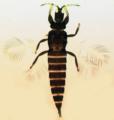Haplothrips verbasci
Recognition data
Distinguishing features
Both sexes fully winged. Body and legs dark brown, fore tarsi and apices of fore tibiae bright yellow; antennal segments III–VI bright yellow, VI shaded at apex; major setae on head and pronotum brown; fore wing pale with extreme base shaded. Head slightly longer than wide; maxillary stylets about 0.25 of head width apart, retracted to postocular setae, maxillary bridge distinct; postocular setae bluntly pointed, longer than eyes. Antennae 8-segmented, segment III with two sensoria, IV with four sensoria; segment VIII slender and very slightly constricted at base. Pronotum with five pairs of long bluntly pointed setae; epimeral sutures complete; prosternal basantra small, ferna present, mesopresternum eroded to paired lateral triangles that are sometimes weakly joined medially. Fore tarsal tooth small and sharply pointed. Fore wing constricted medially, with about 12 duplicated cilia; sub-basal setae bluntly pointed. Tergites II–VII with setae S1 bluntly pointed; tergite IX setae S1 and S2 pointed; tube relatively long, about 2.5 times as long as basal width.
Male similar to female, fore tarsal tooth broadly based; tergite IX setae S2 shout and stout; pseudovirga of aedeagus slender.
Related and similar species
H. verbasci has been referred, at times, to the genus Neoheegeria because of its relatively long mouth cone and long major setae, but that genus is now restricted to a few European species that have three sensoria on the third antennal segment (Minaei et al., 2007). The genus Haplothrips, one of the three most species rich genera of Thysanoptera, currently includes about 245 species worldwide (Mound & Minaei, 2007), these being found mainly from Europe across the Old World. No member of the genus is known to be endemic to the Neotropics, although a few species come from southern South America (Mound & Zapater, 2003), and only 17 species are listed from Mexico and North America (Mound & Marullo, 1996) with six of these recorded from California (Hoddle et al. 2004). Little is known of the biology of the Californian species, although elsewhere the species of Haplothrips are associated particularly with the flowers of Poaceae and Asteraceae.
Taxonomic data
Current valid name
Haplothrips verbasci (Osborn)
Original name and synonyms
- Phloeothrips verbasci Osborn, 1897: 228
- Trichothrips femoralis Moulton, 1907: 61
Family placement
Phlaeothripidae, Phlaeothripinae
Common names
Mullein thrips
Biological data
Life history
Breeding in flowers and on flowering stems.
Host plants
Verbascum thapsus (Scrophulariaceae).
Tospoviruses vectored
None
Crop damage
None
Distribution data
Area of origin
Probably northern Europe.
Distribution
Europe and North America.





